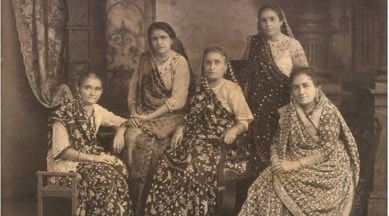📣 For more lifestyle news, click here to join our WhatsApp Channel and also follow us on Instagram
‘A symbol of Parsi cultural heritage’: Tracing the history and endangered artistry of Gara embroidery
This rich craft traces its roots to the 19th century when Parsi traders and artisans migrated to India from Persia (modern-day Iran)

India boasts a rich history of traditional crafts, with an array of embroidery techniques, handiwork, and artistry. These crafts are a living testament to the country’s cultural diversity and heritage. While some of these traditions continue to flourish and be reimagined, others stand at risk of fading away. One such art is Parsi Gara embroidery, which holds a special place in the cultural heritage of the Parsi community of India.
“Parsi Gara, also known as Parsi Gara embroidery or Parsi Gara work, is a traditional embroidery style originating from the Parsi community in India. It is known for its intricate and highly detailed floral and nature-inspired designs. Typically, Parsi Gara embroidery is done on silk or georgette fabrics using colourful silk threads,” said artist Manisha Gawade, director, Ehsaas – a digital showcase of authentic handlooms of India, New Delhi.
monthly limit of free stories.
with an Express account.
In the Parsi Gara embroidery technique, the motifs often include flowers, birds, butterflies, and other elements of nature, and they are meticulously stitched onto garments like saris, blouses, and dresses. “This embroidery style is highly regarded for its craftsmanship and is considered a symbol of Parsi cultural heritage,” she said.
This rich craft traces its roots to the 19th century when Parsi traders and artisans migrated to India from Persia (modern-day Iran). “When the Parsis first settled in Gujarat, Parsi men started trading with China. Initially, they went to buy tea from China and sell it in India. During the trade sojourns, they discovered a beautiful silk fabric called ‘gaaj’ or ‘paaj’. Such exquisite was its beauty that they ended up buying yards for their wives,” Gawade shared.
The Parsis brought the embroidery technique to India while trading with China. Soon, the embroidery style flourished in the textile centres of Mumbai and Surat.
Gawade shared that Parsi Gara embroidery is often associated with Parsi weddings, wherein brides may wear saris adorned with these exquisite embroideries. The name ‘Gara’ is derived from a Gujarati word for ‘sari’ or ‘wrapper’, reflecting its primary use in adorning saris.
Parsi Gara weavers shared that the design is first drawn on paper, followed by the formation of the sample colour. The craftsmen study the designs and trace them on the sari. Making a Gara sari is an elaborate process, and it takes between two to eight months to complete one. “It will take four of us about one to two months to complete a single dupatta. A very fine needle is used to create these intricate motifs,” Mehboob, a Parsi Gara weaver working for the past 15 years, said.
An interesting aspect of the design, Gawade said, is that each craftsman specialises in a particular motif. A Gara can be fully embroidered or have a border with partial embroidery. “The saris/dupattas can begin at around Rs 12,000 and can go up to Rs 1,20,000. The more elaborate the design, the longer it takes to make,” she said.
Although the Parsi Gara embroidery continues to be treasured for its beauty and craftsmanship and serves as a reminder of the rich cultural heritage of the Parsi community and their ability to adapt and contribute to the diverse tapestry of Indian culture, Gawade said the state of the craftsmen is not good. “There are only 55 trained master karigars (weavers) left since the process is labour intensive and they are paid only around Rs 400 per day… Some of them live in remote pockets of Bengal and the money is not enough to support their families.”
With the diminishing demand for the craft, the children of these weavers are no longer interested or encouraged to carry forward the tradition of Parsi Gara embroidery. Additionally, the demand has diminished owing to the low birth rate of the Parsi community.
“I have been doing this craft for the past 20 years. However, I am now planning to quit since it is very difficult to sustain with this money. The craft will die one day if there’s no money and people aren’t interested anymore,” Sheikh Khadim Ali, another Parsi Gara weaver, said. Unfortunately, Ali is not the only Parsi Gara weaver planning to quit the craft owing to lack of money. Sheikh Raju, Sohan Bimal, and other craftsmen, too, are contemplating changing professions.
To revive this dying craft, an increase in demand and awareness is the key. “The higher the demand, the higher the supply and we will be able to rescue it from extinction. The government can also help with the promotion of the Parsi Gara in international quarters,” Gawade said.
Hoping for the revival of Parsi Gara embroidery, Gawade recently presented the 7th online edition of the ‘Ehsaas – Threads of India 2023’ exhibition with a special focus on this Parsi craft.
📣 For more lifestyle news, follow us on Instagram | Twitter | Facebook and don’t miss out on the latest updates!
📣 For more lifestyle news, click here to join our WhatsApp Channel and also follow us on Instagram